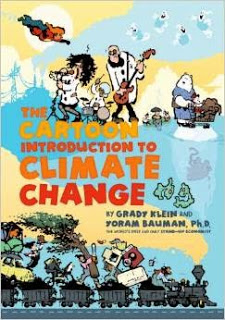| Online: | |
| Visits: | |
| Stories: |

| Story Views | |
| Now: | |
| Last Hour: | |
| Last 24 Hours: | |
| Total: | |
The Cartoon Introduction to Climate Change — the review
Read aguanomics http://www.aguanomics.com/ for the world’s best analysis of the politics and economics of water
I just read this 200pp book by Yoram Bauman (writer) and Grady Klein (illustrator) in one two-hour sitting. It’s a great book: funny, balanced, beautiful, logical. I got my copy over a year ago, after its successful Kickstarter campaign, but lost it until today. I regret the delay, in terms of writing this review in support of the book, but it’s not too late for you and yours to benefit from its entertaining information.
NB: I read the paperback. I am not sure the Kindle-version will give the same experience.
The book is divided into three parts: Observations, Predictions and Actions.
Observations starts with earth’s and the roles of carbon and energy. It ends with a discussion of climate science and the scientific method, which will be helpful to people who have a hard time with “theories” (like the theory of gravity) or low probability events. The most impressive thing I learned in this section is how we *should* be heading to a stage of global cooling except that we are emitting so many GHGs (green house gases, often shortened to “carbon”) that we are headed towards warming.
Predictions goes from global warming to its impacts on the water cycle (well done!), life on earth and long range impacts. This section points out that rich people will probably not die from climate change as poor people will (a prediction that some people feels relieves them of the need to think about these issues) while clarifying that it could get pretty bad — especially if you expect to have dry feet in Florida.
Actions explains why action is hard (tragedy of the commons), how technical fixes (everything from wind power to toilet regulations) might work, and why economists recommend carbon taxes as a better solution that subsidies to clean energy.
Bauman is extremely generous (in my mind) in allowing for a successful cap and trade regime (many have been distorted by corruption) as well as acknowledging that many solutions can be tried simultaneously, as long as people keep their eye on the goal of reducing atmospheric GHGs. He explains how British Columbia’s carbon tax has reduced emissions at the same time as it generates revenue that makes lower income taxes possible.
Bottom Line: The illustrations, clever wording and memorable characters make this book a delight to read. Given the heavy science and policy that it explains, this is truly a masterpiece. I give this book FIVE STARS.
Source: http://www.aguanomics.com/2015/05/the-cartoon-introduction-to-climate.html




